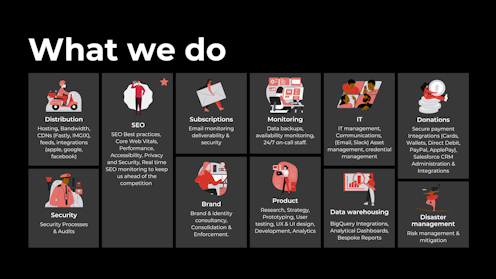An update from our CEO on how technology powers The Conversation
- Written by Lisa Watts, Chief Executive, The Conversation

As a reader of The Conversation you might be surprised to know that our technology platform, which was designed and built in Australia, powers all of The Conversation’s eight international editions; Australia & New Zealand, UK, US, Africa, France, Canada, Indonesia and Spain.
That means we support four languages, over 500 university members, more than 90,000 academics and 300 staff globally that use the platform. Each quarter we produce approximately 5,000 articles. In May we had 4.5 million users in Australia and New Zealand and we generated 42 million pageviews from our platforms plus Creative Commons republication.
All of this is managed by a small team of fewer than ten software engineers with a ratio 1 to 30 Conversation staff. Most of their time is allocated to keeping our platform secure and gremlin-free and supporting the online presentation of our articles. The annual cost of all our technology, hosting, data, design and security investment is more than $2 million.
Over the past year, we’ve completed a large infrastructure clean up, decommissioned our own data warehouse and migrated all applications to Google Cloud. We’ve had a focus on accessibility and over the last two years we have improved our Google lighthouse score from 72% to 98%, which means more people can see and interact with our articles.
Over the past two years we have also invested more in cybersecurity. And in the next six months we’ll be launching an updated website that will be more adaptable for each edition and more user-friendly for our readers. With our lean resources, this development has been a long term project.
There are so many more people we could reach with more support.
Most of our cost base pays for the team and contractors who help The Conversation publish timely and freely accessible articles, and there is little left to support the digital innovations that would enhance our coverage and increase the reach and shareability of our work.
It’s not easy to find philanthropic support for technology, but without a fast, safe, well-run and engaging platform, The Conversation could be relegated to the digital abyss and our explanatory journalism left unread.
If you want to help us meet our annual technology costs and ensure evidence-based journalism remains freely and widely available, please consider supporting us with a tax deductible donation[1]. To talk to me directly, get in touch via email[2].
References
- ^ supporting us with a tax deductible donation (donate.theconversation.com)
- ^ get in touch via email (theconversation.com)
Read more https://theconversation.com/an-update-from-our-ceo-on-how-technology-powers-the-conversation-207923

















